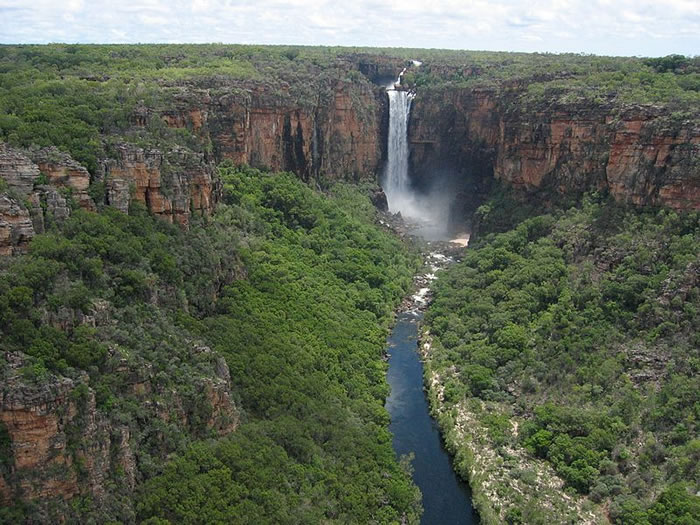Kakadu National Park |

Connect with the oldest living culture on earth. The rugged and remote beauty of Kakadu has stories to share that will take your breath away and touch your heart.
In Australia's biggest national park you will find ancient landscapes with thundering waterfalls, lush rainforests, wandering wetlands, exotic wildlife and ancient rock art.
Covering nearly 20,000 square kilometres, Kakadu National Park is a World Heritage listing renowned for both its cultural and natural values.
There's so much to do within Kakadu's 20,000 square kilometres, but some things are just not to be missed.
Kakadu's incredible biodiversity is recognised all over the world.
The park's World Heritage-listed landscapes change dramatically from one end of the park to the other, encompassing mangrove-lined coastlines, sweeping stone country and endless floodplains and wetlands.
Its savanna woodlands and lowlands, which make up about 80% of the park, house a huge variety of plants and animals.
Kakadu is home to 2,000 plant species, around one-third of all Australian bird species and about one-fifth of all Australian mammals.
Some of these animals are threatened or endangered and many aren't found anywhere else in the world. And there are other species still waiting to be discovered.
Come to Kakadu to experience nature at its most remarkable.
We are Bininj/Mungguy
Aboriginal people are called Bininj in the north of the park and Mungguy in the south. Some of us live in Kakadu's towns and others live in more remote parts of the park, but all of us have a deep spiritual connection to our country.
The land and its people have always been linked. Caring for our land and its wildlife is fundamental to our culture. Art, language, ceremonies, kinship and caring for country are all aspects of cultural responsibility that we have passed from one generation to the next, since the Creation time.
Our clans
Our clans consist of two or more family groups sharing ownership of an area of land. Clan boundaries are passed from one generation to the next, generally through the father. Kakadu has about 19 clan groups.
Kinship
Visit the Warradjan Aboriginal Cultural Centre for a great display and interactive game to help you understand kinship.
In the Kakadu area, our kinship system is very complex. All people, plants, animals, songs, dances, ceremonies and land are divided into two groups, or 'moieties': Duwa or Yirridja. Each moiety is subdivided into eight 'skin' groups. A child's skin group is determined by their mother's skin group but they inherit their moiety from their father.
In simple terms, kinship can be described as a system that defines how people relate to each other. Through the use of 'skin' names we identify the people around us as mothers, fathers, uncles, aunts, cousins, potential marriage partners, and so on, and modify our behaviour accordingly. Almost every aspect of day-to-day communication with other Aboriginal people is governed by kinship ties.
Respecting culture
Our local Aboriginal culture has a set of social behaviours and customs which are considered good manners.
Traditionally, Aboriginal people (Bininj/Mungguy) do not greet each other every time they meet. However, we are used to non-Aboriginal people doing so and may expect a 'hello'.
Many Bininj/Mungguy do not use personal names as freely as non-Aboriginal people do and we often address each other by kinship terms.
Bininj/Mungguy appreciate privacy. It is good manners not to take photographs of us without permission.
Some Bininj/Mungguy find constant eye contact uncomfortable.
In Bininj/Mungguy culture it is important to listen carefully and consider the response carefully before giving an answer.
It is polite to say goodbye when leaving. Our word for goodbye is 'bobo' (pronounced bor bor).
Show respect by not entering restricted areas. They may be sacred sites, ceremonial sites, burial grounds or even someone's home.
UNESCO World Heritage
Kakadu is dual-listed on the UNESCO World Heritage List for its outstanding natural and cultural values.
The park is a living cultural landscape. Its archaeological sites record the skills and way of life of Aboriginal people over tens of thousands of years. Kakadu's rock art documents Indigenous creation stories and makes up one of the longest historical records of any group of people in the world.
Kakadu's ancient escarpment and stone country spans more than two billion years of geological history. It's rivers and coastal floodplains are more dynamic environments, shaped by changing sea levels and big floods every tropical summer.
Kakadu National Park was first added to the World Heritage List in 1981, with further areas added in 1987, 1992 and 2011.
Don't miss...
 Ubirr
Ubirr Gunlom Falls
Gunlom Falls Nourlangie
Nourlangie Maguk
Maguk Yellow Water
Yellow Water Kubara
Kubara Motor Car Falls
Motor Car FallsConnect with the oldest living culture on earth.
"Our land has a big story. Sometimes we tell a little bit at a time. Come and hear our stories, see our land. A little bit might stay in your hearts. If you want more, you come back."
- Jacob Nayinggul, Manilakarr clan
THINGS TO DO
 Walks
Walks Waterfalls
Waterfalls Croc spotting
Croc spotting Ranger-guided activities
Ranger-guided activities Rock art
Rock art Birdwatching
Birdwatching Fishing and boating
Fishing and boatingGetting Here
Kakadu is a scenic three hour drive from Darwin on sealed roads that are passable year-round.
Take the Stuart Highway for 35km until you reach the Arnhem Highway turn off to Kakadu.
Turn left onto the Arnhem Highway and drive 216km.
If you are staying at the Mercure Kakadu Crocodile Hotel continue straight following the signs to Jabiru. You will need to turn right off the highway toward the township itself. Drive 2 km ahead, you will now see the Crocodile Hotel on your left hand side.
If you are staying at Cooinda Lodge Kakadu or visiting for a Yellow Water Cruise turn right heading towards Cooinda/Pine Creek.
Continue on this road for approximately 50km. You will pass Nourlangie Rock, Mirrai Lookout, and Jim Jim billabong on your left. Shortly after the Jim Jim Billabong sign you will need to turn right towards Cooinda. Continue for approximately 4km, you will now arrive at the Lodge.
❊ Address ❊
⊜ Kakadu National Park Kakadu View Map
✆ Telephone: (08) 8938 1120
❊ More Information ❊
→
parksaustralia.gov.au
❊ Also See.. ❊
➼ Warradjan Aboriginal Cultural Centre
➼ Mercure Kakadu Crocodile Hotel
➼ Cooinda Lodge Kakadu
Update Page







